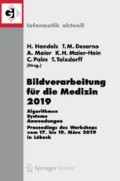Zusammenfassung
In this contribution, we propose a 2D deep segmentation refinement approach, that is inspired by the U-Net architecture and incorporates result-dependent loss adaptation. The performance of our method regarding segmentation quality is evaluated on the example of hip joint segmentation in T1-weighted MRI data sets. The results are compared to an ordinary U-Net implementation. While the segmentation quality of the proximal femur does not significantly change, our proposed method shows promising improvements for the segmentation of the pelvic bone complex, which shows more shape variability in the 2D image slices along the longitudinal axis.
Access this chapter
Tax calculation will be finalised at checkout
Purchases are for personal use only
Preview
Unable to display preview. Download preview PDF.
Literatur
Chu C, Chen C, Liu L, et al. FACTS: fully automatic CT segmentation of a hip joint. Ann Biomed Eng. 2015;43(5):1247–1259.
Xia Y, Fripp J, Chandra SS, et al. Automated bone segmentation from large field of view 3D MR images of the hip joint. Phys Med Biol. 2013;58(20):7375.
Chandra SS, Xia Y, Engstrom C, et al. Focused shape models for hip joint segmentation in 3D magnetic resonance images. Med Image Anal. 2014;18(3):567–578.
Klein A, Warszawski J, Hillengaß, et al. Towards whole-body CT bone segmentation. Proc BVM. 2018; p. 204–209.
Ronneberger O, Fischer P, Brox T; Springer. U-net: convolutional networks for biomedical image segmentation. Proc MICCAI. 2015; p. 234–241.
Ravishankar H, Venkataramani R, Thiruvenkadam S, et al.; Springer. Learning and incorporating shape models for semantic segmentation. Proc MICCAI. 2017; p. 203–211.
Newell A, Yang K, Deng J. Stacked hourglass networks for human pose estimation. Proc ECCV. 2016; p. 483–499.
Author information
Authors and Affiliations
Corresponding author
Editor information
Editors and Affiliations
Rights and permissions
Copyright information
© 2019 Springer Fachmedien Wiesbaden GmbH, ein Teil von Springer Nature
About this paper
Cite this paper
Pham, D.D., Dovletov, G., Warwas, S., Landgraeber, S., Jäger, M., Pauli, J. (2019). Deep Segmentation Refinement with Result-Dependent Learning. In: Handels, H., Deserno, T., Maier, A., Maier-Hein, K., Palm, C., Tolxdorff, T. (eds) Bildverarbeitung für die Medizin 2019. Informatik aktuell. Springer Vieweg, Wiesbaden. https://doi.org/10.1007/978-3-658-25326-4_14
Download citation
DOI: https://doi.org/10.1007/978-3-658-25326-4_14
Published:
Publisher Name: Springer Vieweg, Wiesbaden
Print ISBN: 978-3-658-25325-7
Online ISBN: 978-3-658-25326-4
eBook Packages: Computer Science and Engineering (German Language)

